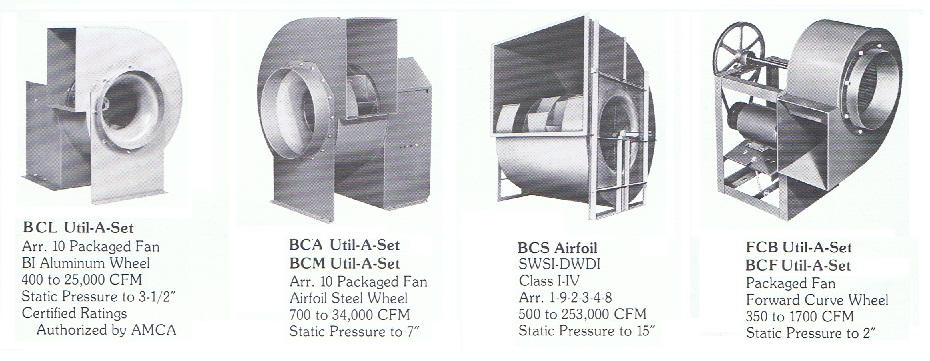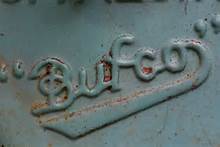

Industrial Centrifugal Fans manufactured by experts!
Industrial Blowers are designed to handle industrial process air. Fan features a radial design wheel, available as air-handling AH wheel, or material handling MH wheel. Fan construction features rigid housing, braced for additional strenght, heavy duty shaft, heavy duty pillow block ventilator bearings, shaft and bearing pedestal, adjustable motor base, and weather motor cover. Flanged Inlet / Outlet, Companion flanges, Access Door, Drain, Plug, Damper, Spark Resistant Construction, Abrasion Resistant Construction, High Temperature Fan Construction to 800 F, and vibration insulation are optional. Special alloys and coatings are avaialble upon request.
Pressure Blowers and Turbo Pressure Blowers are general industrial fans designed to handle industrial process air at high pressure. Fan features pressure blower all welded steel radial wheel, which on junior pressure blowers is of cast aluminum design. Fan construction includes heavy duty rigid housing, which on junior fans is of cast iron design, reinforced with braces, blower wheel, heavy duty shaft, heavy duty pillow block fan bearings, shaft and bearing pedestal, adjustable motor base, and weather motor cover. Flanged Inlet, Flanged Outlet, Companion flanges, Access Door, Drain, Plug, Inlet Screen, Outlet Guard, Dampers, Spark Resistant Ventilator Construction, Abrasion Resistant Blower Construction, High Temperature Construction to 800 F, and vibration insulation are optional accessories. Direct drive fans are avialble in Arr. 8 construction. Belt drive arrangements utilize standard V-belt drive supplied in fixed pitch, or adjustable pitch option. Special alloys and coatings are avaialble upon request.
Plug Fans are designed to handle industrial process air for air recirculation in ovens and furnaces. Fan features inlet cone with venturi profile, a non-overloading backward inclined, backward curved, or airfoil wheel, heavy duty shaft and bearings, shaft and bearings pedestal reinforced with braces, adjustable motor base, and belt guard. Spark Resistant Construction, Abrasion Resistant Construction, High Temperature Construction to 1500 F, are optional accessories. Direct drive fans are avialble in Arr. 4 construction. Belt drive arrangements utilize standard V-belt drive supplied in fixed pitch, or adjustable pitch option. Special alloys and coatings are avaialble upon request.
Accessories: Prefabricated unitary base, safety bird screen, shaft and bearing guard, belt guard, weather and motor cover, automatic and Motor-Operated Backdraft Dampers, inlet vane dampers, flanged inlet, flanged outlet, access door, drain and plug, spring or rubber vibration isolators, and high temperature construction are avaialble upon request. Special protective coatings and alloys(aluminum, or stainless) are optional. Pre-wired and loose Safety Disconnect Switch, and Speed Controller are optional.
All models power roof
ventilators bear the AMCA Seal.
Fan Types
Fans are classified according to the direction of flow through the
ventilator impeller:
- Axial Flow Fan: Axial Flow: Air flows through the impeller parallel
to and at a Air flows through the impeller parallel to, and at a
constant distance from the fan axis. The pressure rise is provided by
the direct action of the blower blades
- Centrifugal or radial flow Fan: Air enters parallel to the axis of
the fan and turns through 90 degrees and is discharged radially through
the fan blades. The blade force is tangential causing the air to spin
with the blades and the main pressure is attributed to this centrifugal
force
- Mixed flow Fan: Air enters parallel to the axis of the fan and turns
through an angle which may range from 300 to 900 g yg . The p py
ressure rise is partially by direct blade action and partially by
centrifugal action
- Cross Flow Fan: air enters the ventilator impeller at one part of the
outer periphery flows inward and exits at another part of the outer fan
periphery.
Applications of Centrifugal Canada Blower fans:
• Air Fan
• Scanner Air Fan
• Booster Air Fan
• Burner Air Fan
• Degasser Blower Degasser Blower
• Combustion Air Fan
• Oil Vapour Exhaust Fan
• Purge Gas Blowers
• Inline Fans
• Supply Air Fan
• Exhaust Air Fan Exhaust Air Fan
• Ventilation Fan
• Radial Blowers
• Turbo Blowers (Centrifugal)
• FD Fan
• ID Fan
• In-series Blowers
• Igniter Air Fan
• Seal Air Fan
Canada Blower Fan / Blower Blade Types:
- Impeller fan blades are manufactured manufactured either laminar
laminar (flat, constant constant thickness) or aerofoil shape and
generally hollow
- Aerofoil blades have greater efficiencies (up to 90%) compared to
constant constant thickness thickness blades, with the advantages
advantages of efficiency efficiency spread over the characteristic and
lower noise generation
Blower Types:
- Centrifugal blowers typically operate against pressures of 0.35 to
0.70 kg/cm2, but can achieve much higher pressures
- Also used to produce negative pressures for industrial vacuum systems
- Major types are; centrifugal blower and positive-displacement blower
- The impeller is typically gear-driven and rotates as fast as 15,000
rpm
- Efficiency Efficiency drops with multi-staging staging due to the
path taken from stage to stage
- One characteristic is that airflow tends to drop drastically as
system pressure increases
- Canada Blower Positive blowers have rotors, which "trap" air and push
it through housing.
- Positive-displacement blowers provide a constant volume of air even
if the system pressure pressure varies. They are especially especially
suitable suitable for ventilation applications prone to clogging,
- They turn much slower than centrifugal blowers (e.g. 3600 rpm), and
are often belt driven to facilitate speed changes
Merits of Axial and Centrifugal Fans:
- Axial fans offer better efficiency over a wider range of duties
whereas Axial fans offer better efficiency over a wider range of duties
whereas the centrifugal fans can have a higher efficiency, albeit over
a smaller range, on a single performance curve.
- The performance of a single speed axial fan can be altered simply by
adjustment to the impeller blade pitch angle.
- Axial fans are generally considered to be more easily accessible for
maintenance.
- Axial fans generally run faster than centrifugal as a consequence are
much ii noisier.
- Axial fan impellers are generally manufactured from aluminum in an
effort to keep weight to a minimum. As a consequence the potential for
effort to keep weight to a minimum. As a consequence the potential for
erosion is greater, particularly if there is water in the shaft.
- The light material used in the blades along with the high rotational
speed of axial fans make them prone to erosion, and even in good (dry)
conditions it is reasonably expected that this erosion will have
conditions it is reasonably expected that this erosion will have
significantly reduced the fan performance within five years.
- Canada Blower centrifugal fan impellers are fabricated from plate and
are generally hollow. As a consequence when there is water in the fan
shaft the nose of the blade is prone to pitting allowing water to enter
the hollow section. Sufficient water in this section will cause the
blower impeller to become unbalanced, and if allowed to continue it
will result in high vibration and eventual failure of the impeller
shaft.
Merits of Single and Multiple Fans:
- Single fan installations are generally less expensive than multiple
fan installations.
- Multiple fan installations have the advantage of airflow redundancy,
i.e. a percentage of airflow will always be available whilst a fan is
off line for maintenance or component change out.
- Single fan options do not provide any capacity for redundancy airflow
The purchase of fan spares. The purchase of spares (motor impeller
shafts bearings motor, impeller, shafts, bearings, blades etc) is good
management and should be included as upfront capital expenditure.
Stock of tubeaxial & vaneaxial inline duct fans, blower and fan repair / balancing, replacement centrifugal and axial fan blades, axial duct fans, aluminum pressure blowers, FRP ventilators, dust collectors blowers fans, dust collection fan ventilators, high temperature oven circulation fans, explosion proof ventilatoprs, spark reistant fans and blowers, induce & force draft fans, fan blower impellers. Sales of regenerative blowers, high pressure ventilators, positive displacement pressure blowers.
| Supply and exhaust fans aid the
thermodynamic forces in heating or cooling fluids for process systems.
Dry surface or wet surface heat exchangers, shell and tube and
evaporative cooling systems use Canada Blower Axial, Centrifugal Fan or
Pressure Blower designs. Canada Blower fans are available with
corrosion-resistant or alloy construction for severe-duty environments;
low noise, high-efficiency fans are required for hospital and critical
commercial HVAC installations. ventilating.com fanblower.com highpressureblower.net industrialblowerfan.com industrialfanblower.net industrialfanblower.com pressureblower.net northernindustrialsupplycompany.com industrialpressureblower.com tenderall.com chicagoblowercanada.com cbblower.com buffaloblower.com buffalofan.com nis-co.com canadianblower.com olegsystems.com canadablower.com abbblower.com acmefan.net industrialblower.net fansandblowers.net americanblower.net barryfan.com cincinnatifan.net canadafans.com barryfan.net pennbarry.net pennfan.net tcffan.com |
| Industrial
process and OEM blowers, Canadian Blower custom built fans,
ventilators, dust collectors, combustion pressure blowers
Explosion
proof backwardly inclined; airfoil;
radial and radial-tip fans and blowers. Pressure blowers; plug
fans; air kits; centrifugal and axial ventilators.
|

